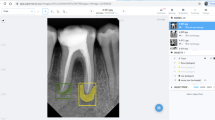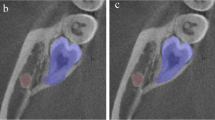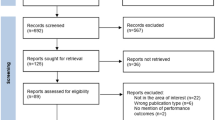Abstract
Objectives
An evaluation of the effectiveness of a new computational system proposed for automatic classification, developed based on a Siamese network combined with Convolutional Neural Networks (CNNs), is presented. It aims to identify endodontic technical errors using Cone Beam Computed Tomography (CBCT). The study also aims to compare the performance of the automatic classification system with that of dentists.
Methods
One thousand endodontically treated maxillary molars sagittal and coronal reconstructions were evaluated for the quality of the endodontic treatment and the presence of periapical hypodensities by three board-certified dentists and by an oral and maxillofacial radiologist. The proposed classification system was based on a Siamese network combined with EfficientNet B1 or EfficientNet B7 networks. Accuracy, sensivity, precision, specificity, and F1-score values were calculated for automated artificial systems and dentists. Chi-square tests were performed.
Results
The performances were obtained for EfficienteNet B1, EfficientNet B7 and dentists. Regarding accuracy, sensivity and specificity, the best results were obtained with EfficientNet B1. Concerning precision and F1-score, the best results were obtained with EfficientNet B7. The presence of periapical hypodensity lesions was associated with endodontic technical errors. In contrast, the absence of endodontic technical errors was associated with the absence of hypodensity.
Conclusions
Quality evaluation of the endodontic treatment performed by dentists and by Siamese Network combined with EfficientNet B7 or EfficientNet B1 networks was comparable with a slight superiority for the Siamese Network.
Clinical relevance
CNNs have the potential to be used as a support and standardization tool in assessing endodontic treatment quality in clinical practice.



Similar content being viewed by others
Availability of data and materials
The database used in this work is available upon request at https://github.com/felipebsferreira/periapical-lesion-dataset, with the recommendations for use and application, which was presented in [15]. In this work, the classification of the quality of endodontic treatment was added to the database, which is available with this update at the same link.
References
Lin LM, Skribner JE, Gaengler P (1992) Factors associated with endodontic treatment failures. J Endod 18(12):625–627
Lin LM, Rosenberg PA, Lin J (2005) Do procedural errors cause endodontic treatment failure? J Am Dent Assoc 136(2):187-193
Nascimento EHL, Gaêta-Araujo H, Andrade MFS, Freitas DQ (2018) Prevalence of technical errors and periapical lesions in a sample of endodontically treated teeth: a CBCT analysis. Clin Oral Investig 22:2495–2503
Gaêta-Araujo H, Fontenele RC, Nascimento EHL, Nascimento MCC, Freitas DQ, de Oliveira-Santos C (2019) Association between the root canal configuration, endodontic treatment technical errors, and periapical hypodensities in molar teeth: a cone-beam computed tomographic study. J Endod 45(12):1465–1471
Ng Y-L, Mann V, Gulabivala K (2011) A prospective study of the factors affecting outcomes of nonsurgical root canal treatment: Part 1: periapical health. Int Endod J 44(7):583–609
Karamifar K, Tondari A, Saghiri MA (2020) Endodontic periapical lesion: An overview on the etiology, diagnosis and current treatment modalities. European Endod J 5(2):54
Khanagar SB, Al-ehaideb A, Maganur PC, Vishwanathaiah S, Patil S, Baeshen HA, Sarode SC, Bhandi S (2021) Developments, application, and performance of artificial intelligence in dentistry–A systematic review. J Dent Sci 16(1):508–522
Schwendicke F, Golla T, Dreher M, Krois J (2019) Convolutional neural networks for dental image diagnostics: a scoping review. J Dent 91:103226
Lee J-H, Kim D-H, Jeong S-N, Choi S-H (2018) Detection and diagnosis of dental caries using a deep learning-based convolutional neural network algorithm. J Dent 77:106–111
Endres MG, Hillen F, Salloumis M, Sedaghat AR, Niehues SM, Quatela O, Hanken H, Smeets R, Beck-Broichsitter B, Rendenbach C, Lakhani K, Heiland M, Gaudin RA (2020) Development of a deep learning algorithm for periapical disease detection in dental radiographs. Diagnostics 10(6):430
Moidu NP, Sharma S, Chawla A, Kumar V, Logani A (2022) Deep learning for categorization of endodontic lesion based on radiographic periapical index scoring system. Clin Oral Investig 26(1):651–658
Setzer FC, Shi KJ, Zhang Z, Yan H, Yoon H, Mupparapu M, Li J (2020) Artificial intelligence for the computer-aided detection of periapical lesions in cone-beam computed tomographic images. J Endod 46(7):987–993
Zheng Z, Yan H, Setzer FC, Shi KJ, Mupparapu M, Li J (2021) Anatomically constrained deep learning for automating dental CBCT segmentation and lesion detection. IEEE Trans Autom Sci Eng 18(2):603–614
Ezhov M, Gusarev M, Golitsyna M, Yates JM, Kushnerev E, Tamimi D, Aksoy S, Shumilov E, Sanders A, Orhan K (2021) Clinically applicable artificial intelligence system for dental diagnosis with CBCT. Sci Rep 11(1):15006
Calazans MAA, Ferreira FABS, Alcoforado MdLMG, Santos Ad, Pontual AdA, Madeiro F (2022) Automatic classification system for periapical lesions in cone-beam computed tomography. Sensors 22(17)
Li Y, Zeng G, Zhang Y, Wang J, Jin Q, Sun L, Zhang Q, Lian Q, Qian G, Xia N, Peng R, Tang K, Wang S, Wang Y (2022) AGMB-transformer: anatomy-guided multi-branch transformer network for automated evaluation of root canal therapy. IEEE J Biomed Health Inform 26(4):1684–1695
Zhao L, Pan J, Xu L (2022) Cone-beam computed tomography image features under intelligent three-dimensional reconstruction algorithm in the evaluation of intraoperative and postoperative curative effect of dental pulp disease using root canal therapy. Sci Program 2022
Liang Y-H, Li G, Wesselink PR, Wu M-K (2011) Endodontic outcome predictors identified with periapical radiographs and cone-beam computed tomography scans. J Endod 37(3):326–331
Venskutonis T, Plotino G, Tocci L, Gambarini G, Maminskas J, Juodzbalys G (2015) Periapical and endodontic status scale based on periapical bone lesions and endodontic treatment quality evaluation using cone-beam computed tomography. J Endod 41(2):190–196
Gomes BPFA, Pinheiro ET, Jacinto RC, Zaia AA, Ferraz CCR, Souza-Filho FJ (2008) Microbial analysis of canals of root-filled teeth with periapical lesions using polymerase chain reaction. J Endod 34(5):537–540
Tan M, Le Q (2019) EfficientNet: rethinking model scaling for convolutional neural networks. In: International conference on machine learning, pp 6105–6114
Cohen J (1960) A coefficient of agreement for nominal scales. Educ Psychol Meas 20(1):37–46
Kim H-Y (2017) Statistical notes for clinical researchers: Chi-squared test and Fisher’s exact test. Restor Dent Endod 42(2):152–155
Mann PS (2007) Introductory statistics, 9th edn. John Wiley & Sons, Global
Fawcett T (2006) An introduction to ROC analysis. Pattern Recognit Lett 27(8):861–874
Lemagner F, Maret D, Peters OA, Arias A, Coudrais E, Georgelin-Gurgel M (2015) Prevalence of apical bone defects and evaluation of associated factors detected with cone-beam computed tomographic images. J Endod 41(7):1043–1047
Curvers F, Veken D, Lambrechts P (2016) Prevalence of apical periodontitis and root filled teeth in a Belgian subpopulation found on CBCT images. Int Endod J
Gomes AC, Nejaim Y, Silva AI, Haiter-Neto F, Cohenca N, Zaia AA, Silva EJNL (2015) Influence of endodontic treatment and coronal restoration on status of periapical tissues: a cone-beam computed tomographic study. J Endod 41(10):1614–1618
Karabucak B, Bunes A, Chehoud C, Kohli MR, Setzer F (2016) Prevalence of apical periodontitis in endodontically treated premolars and molars with untreated canal: a cone-beam computed tomography study. J Endod 42(4):538–541
Pauwels R, Brasil DM, Yamasaki MC, Jacobs R, Bosmans H, Freitas DQ, Haiter-Neto F (2021) Artificial intelligence for detection of periapical lesions on intraoral radiographs: comparison between convolutional neural networks and human observers. Oral Surg Oral Med Oral Pathol Oral Radiol Endod 131(5):610–616
Acknowledgements
The authors would like to thank Fundação de Amparo a Ciência e Tecnologia do Estado de Pernambuco (FACEPE) for the financial support, and the Department of Clinical and Preventive Dentistry of UFPE for supporting this research by providing the database.
Funding
This research was funded by FACEPE under grant number IBPG-0767-3.04/20.
Author information
Authors and Affiliations
Contributions
Conceptualization: M. Calazans A. Pontual and F. Madeiro; methodology: M. Calazans, F. Ferreira A. Pontual, M. Pontual and F. Madeiro; software: M. Calazans and F. Ferreira; validation: F. Ferreira, A. Pontual, M. Pontual and F. Madeiro; formal analysis: A. Pontual and M. Pontual; investigation: M. Calazans, F. Ferreira A. Pontual, M. Pontual and F. Madeiro; resources: A. Santos, A. Pontual and M. Pontual; data curation: A. Santos and A. Pontual; writing—original draft preparation: M. Calazans and A. Pontual; writing—review and editing: M. Calazans, F. Ferreira, F. Madeiro, A. Santos, M. Alcoforado, A. Pontual, M. Pontual and F. Ramos-Perez; visualization: M. Calazans; supervision: M. Alcoforado, A. Pontual and F. Madeiro; project administration: F. Madeiro; funding acquisition: F. Madeiro. All authors have read and agreed to the published version of the manuscript.
Corresponding author
Ethics declarations
Ethics approval
The work was submitted and approved by the Research Ethics Committee of the University of Pernambuco, Brazil, under certificate number 4.881.124.
Conflict of interest
The authors declare no conflict of interest.
Additional information
Publisher's Note
Springer Nature remains neutral with regard to jurisdictional claims in published maps and institutional affiliations.
Rights and permissions
Springer Nature or its licensor (e.g. a society or other partner) holds exclusive rights to this article under a publishing agreement with the author(s) or other rightsholder(s); author self-archiving of the accepted manuscript version of this article is solely governed by the terms of such publishing agreement and applicable law.
About this article
Cite this article
Calazans, M.A.A., Pontual, A.d.A., Pontual, M.L.d.A. et al. A system for automatic classification of endodontic treatment quality in CBCT. Clin Oral Invest 28, 223 (2024). https://doi.org/10.1007/s00784-024-05599-1
Received:
Accepted:
Published:
DOI: https://doi.org/10.1007/s00784-024-05599-1




